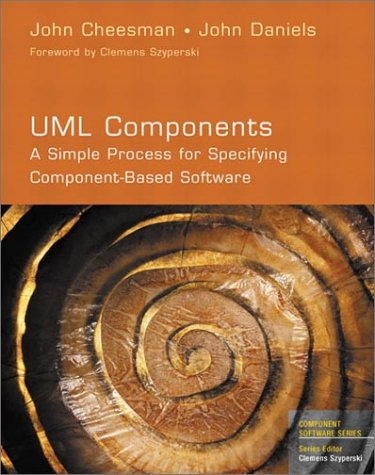
UML Components
Addison Wesley (Verlag)
978-0-201-70851-6 (ISBN)
- Titel ist leider vergriffen;
keine Neuauflage - Artikel merken
The Unified Modeling Language (UML) has gained acceptance as the de facto standard for modeling object software systems -- and, with this book, UML proves itself as an architectural description language, as well. Leading component developers John Cheesman and John Daniels show how to use UML 1.3 to specify and design any mid-to-large-size system utilizing server-side component technologies -- and, along the way, introduce powerful rules and guidelines for enhancing any component architecture. First and foremost, UML Components focuses on process: design processes for producing large-scale component-based systems that can be implemented through existing project management processes. Second, the book offers detailed, expert techniques for using UML 1.3 notation and diagrams to create component specifications that can support change, by allowing for easy substitution as new business problems and technical opportunities arise. The book includes detailed coverage of the Object Constraint Language, practical techniques for configuring and using UML tools, and a complete, start-to-finish case study.
John Cheesman is Director of Enterprise Application Development for ComponentSource. He has extensive experience applying component-based development processes, tools, and standards within large corporations. John specializes in modeling, specification, and repositories, and was a key contributor to the development of the UML. He is a regular speaker at international conferences on component-based development. John Daniels is an independent consultant and trainer. A pioneer of object-oriented concepts and practices, John has applied object and component technology to a wide range of fields during the past fifteen years, from factory automation to banking. He co-developed the Syntropy method, from which the UML Object Constraint Language is directly descended. John is a frequent speaker at international conferences on object technology, components, and development processes, and is co-author of Designing Object Systems: Object-Oriented Modeling with Syntropy (Prentice-Hall, 1994). 0201708515AB04062001
Foreword.
1. Component Systems.
Component Goals.
Component Principles.
Component Forms.
Example: Microsoft Word.
What a Component Isn't.
Component and System Architectures.
System Architectures.
Component Architectures.
Specifying Contracts.
Usage Contracts.
Realization Contracts.
Interfaces versus Component Specifications.
Model Levels.
Summary.
2. The Development Process.
Workflows.
The Impact of the Management Process.
The Evolution of Software Processes.
Accommodating Change.
Workflow Artifacts.
The Specification Workflow.
Component Identification.
Component Interaction.
Component Specification.
Summary.
3. Applying UML.
Why Do We Need This Chapter at All?
Tools.
Extending UML with Stereotypes.
Precision, Accuracy, and Completeness.
UML Modeling Techniques.
Business Concept Model.
Use Case Model.
Use Case Diagrams.
Use Case Descriptions.
Use Case Instances.
Inclusions, Extensions, and Variations.
Business Type Model.
Types.
Structured Data Types.
Interface Type.
Invariants.
Interface Specification.
Interface Specification Package.
Information Model.
Operation Specification.
Component Specification.
Component Object Interaction.
Specification, Not Implementation.
Component Architectures.
Summary.
4. Requirements Definition.
Business Processes.
Business Concept Model.
System Envisioning.
Use Cases.
Actors and Roles.
Use Case Identification.
Use Case Descriptions.
Quality of Service.
Summary.
5. Component Identification.
Identifying Interfaces.
Identifying System Interfaces and Operations.
Make a Reservation.
Take Up Reservation.
Identifying Business Interfaces.
Create the Business Type Model.
Refine the Business Type Model.
Define Business Rules.
Identify Core Types.
Create Business Interfaces and Assign Responsibilities.
Allocating Responsibility for Associations.
Creating Initial Interface Specifications.
Existing Interfaces and Systems.
Component Specification Architecture.
System Component Specifications.
Business Component Specifications.
An Initial Architecture.
Summary.
6. Component Interaction.
Discovering Business Operations.
Some Simple Interactions.
Breaking Dependencies.
Maintaining Referential Integrity.
Component Object Architecture.
Controlling Intercomponent References.
Completing the Picture.
Refining the Interfaces.
Factoring Interfaces and Operations.
Summary.
7. Component Specification.
Specifying Interfaces.
Operation Specification.
Interface Information Models.
Pre- and Postconditions.
A Systematic Process.
From Business Type Model to Interface Information Model.
Invariants.
Snapshots.
Exactly What Does a Postcondition Guarantee?
Specifying System Interfaces.
Business Rule Location.
Specifying Components.
Offered and Used Interfaces.
Component Interaction Constraints.
Inter-Interface Constraints.
Factoring Interfaces.
Summary.
8. Provisioning and Assembly.
What Do We Mean by Target Technology?
Components Realize Component Specifications.
Realization Mappings and Restrictions.
Operation Parameters.
Error and Exception Handling Mechanisms.
Interface Inheritance and Interface Support.
Operation Sequence.
Interface Properties.
Object Creation.
Raising Events.
Application Architecture Correspondence.
Business Components.
Subcomponents.
Integrating Existing Systems.
Purchasing Components.
Assembly.
Summary.
A Final Thought.
References.
Index. 0201708515T04062001
| Erscheint lt. Verlag | 1.11.2000 |
|---|---|
| Verlagsort | Boston |
| Sprache | englisch |
| Maße | 189 x 234 mm |
| Gewicht | 330 g |
| Themenwelt | Informatik ► Software Entwicklung ► Objektorientierung |
| ISBN-10 | 0-201-70851-5 / 0201708515 |
| ISBN-13 | 978-0-201-70851-6 / 9780201708516 |
| Zustand | Neuware |
| Haben Sie eine Frage zum Produkt? |
aus dem Bereich


